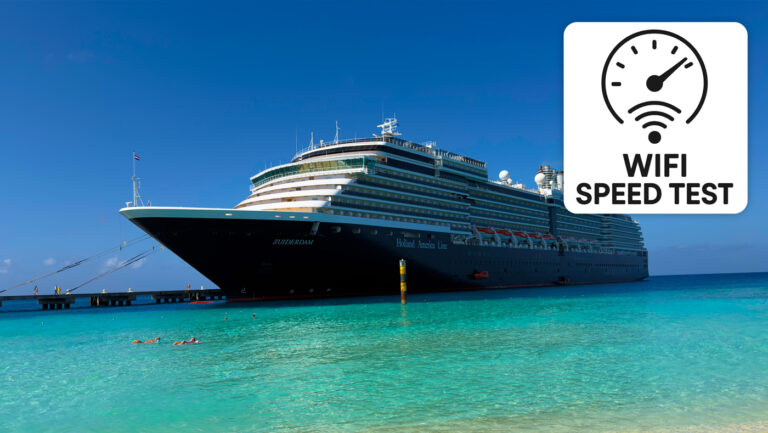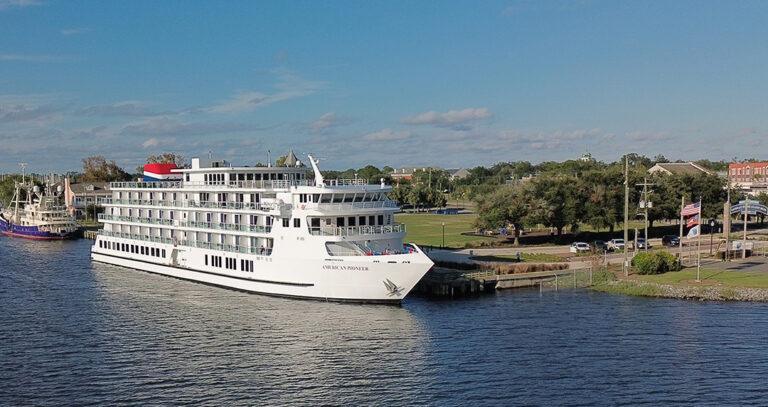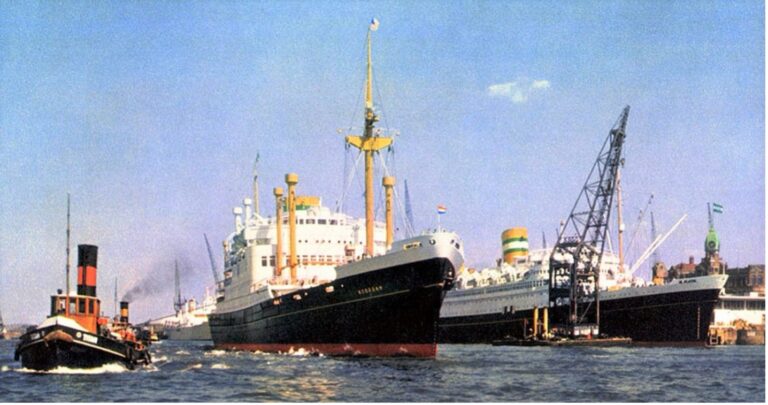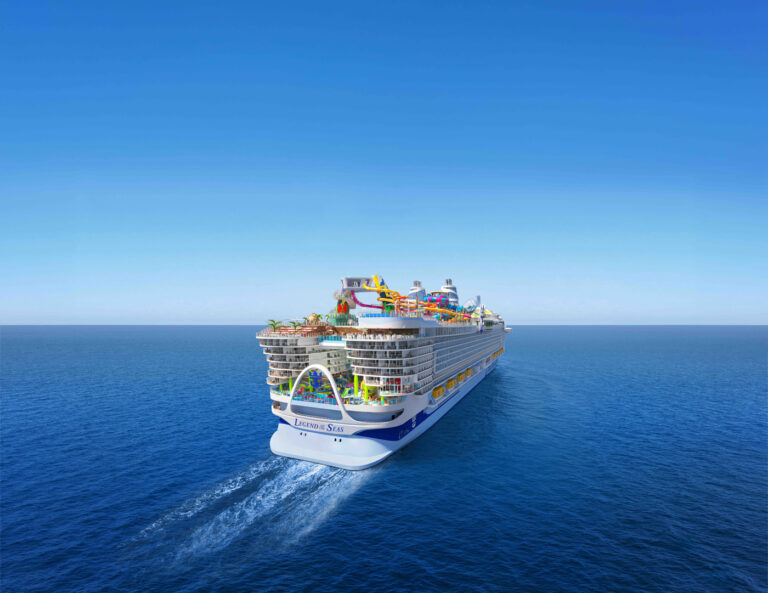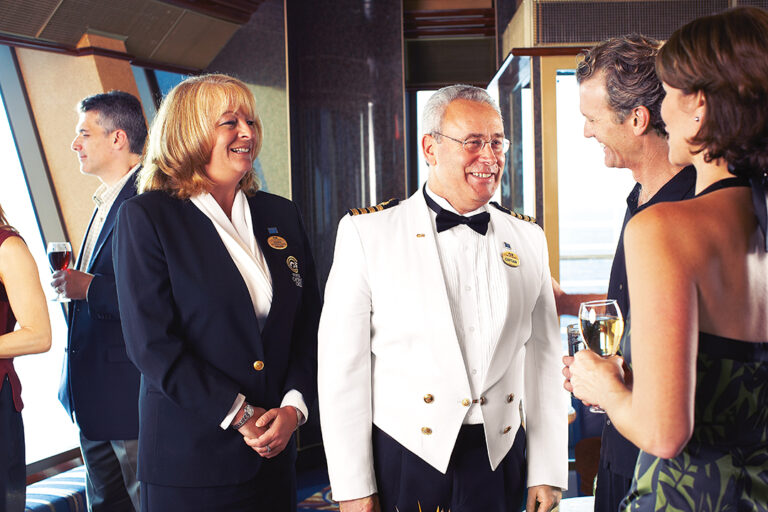End Of The Line For “The Most Interesting Ship” In The World
On July 4, 2025, while people on this side of the Atlantic were celebrating Independence Day, a ship with a grand legacy was delivered to a scrap yard in Ghent, Belgium, where she will be stripped of all recyclable materials, torn apart and melted down to feed the local steel industry.

That vessel, the 15,614-gross ton, 556-passenger MV Astoria, last sailed under charter to British-based Cruise and Maritime Voyages (CMV), a budget operator known for its fleet of vintage cruise ships, all of which were sadly dispatched to the ship breakers shortly after the line went belly up during the Covid pandemic.
Left To Decay
Ironically, the eldest ship in the CMV fleet, Astoria was spared immediate destruction when she was bought in July 2021 by crypto currency entrepreneur Brock Pierce. Pierce had also bought another classic cruise ship, the 1960-built MV Funchal, which was laid up in Lisbon at the time. After spending a small fortune dry-docking Funchal, which he had intended to convert into a floating hotel on the Lisbon waterfront, things quickly went silent.
Soon, it became apparent that Pierce had buyer’s remorse and ditched both projects, leaving the two ships to rot in their respective locales. In the case of Astoria, which was laid up at Rotterdam, there wasn’t even a small crew left to tend to the ship. That became a problem in February 2022, when a storm tore the abandoned Astoria from her moorings and drove her into a neighboring container ship, damaging her stern, before the ship was once again secured to her berth.

Aside from an urban explorer video team that sneaked on board to document her mold-infested interiors a year or so ago, the Astoria remained unattended at Rotterdam until June of this year, when she was put up for auction. The only buyers were the Belgian recycling firm Galloo, who paid the minimum bid of €200,000 (which is basically the price of an expensive sports car) and the ship’s lapsed docking fees.
Two weeks later, a pair of tugs were dispatched to gather the ship and tow her off to Ghent, where she now lies alongside a pile of scrap metal, waiting for the destruction to begin.
Often incorrectly billed as “the world’s oldest cruise ship” (that distinction actually belongs on the high seas to Sea Cloud Cruises‘ 1931-built Sea Cloud; and on the inland waterways to Gota Canal Cruises‘ 1874-built MS Juno), the 1948-built Astoria was nonetheless one of the most long lived, historic and most interesting cruise ships ever put to sea. In her storied career, she was the first post-war (and largest) liner built in Sweden, an East German cruise ship that served for 25 years and often made headlines for the defections of both her passengers and crew, an accommodation ship for refugees, and finally, a completely rebuilt cruise ship with a dedicated following.
Oh, and yes, there was also that incident on July 25, 1956, when she collided with and sank the famed Italian liner SS Andrea Doria with the loss of 51 lives off Nantucket.
Sweden’s First Post War Liner
But first things first. Following World War II, the great Atlantic shipping lines were gradually returning to their various services. One of the most celebrated, Swedish American Line (SAL), operated a small fleet of ships between Gothenburg, on the west coast of Sweden, to New York. In 1946, SAL ordered a passenger cargo ship of relatively modest size, though the largest ever built in Sweden, the 12,165-gross ton MV Stockholm, from the Gotaverken shipyard in Gothenburg.

The ocean liner had a sleek, almost futuristic profile with a sharply raked, reinforced bow built to cut through the icy waters of the North Atlantic in the wintertime. She could carry up to 395 passengers in both first and tourist class and had a 3,000-ton cargo capacity.
Tragic Encounter
In 1953, after the delivery of the larger and more luxurious MS Kungsholm, Stockholm was enlarged to carry 548 passengers. The ship maintained her Atlantic duties and was also deployed on cruises in the off season, enjoying a rather low key, successful career until July 25, 1956. Having departed New York earlier that day, she was off Nantucket in a heavy fog when she collided with Andrea Doria in what became one of the most notorious maritime disasters of the 20th Century, largely because Andrea Doria’s gradual capsizing and sinking were recorded on live television by helicopters.
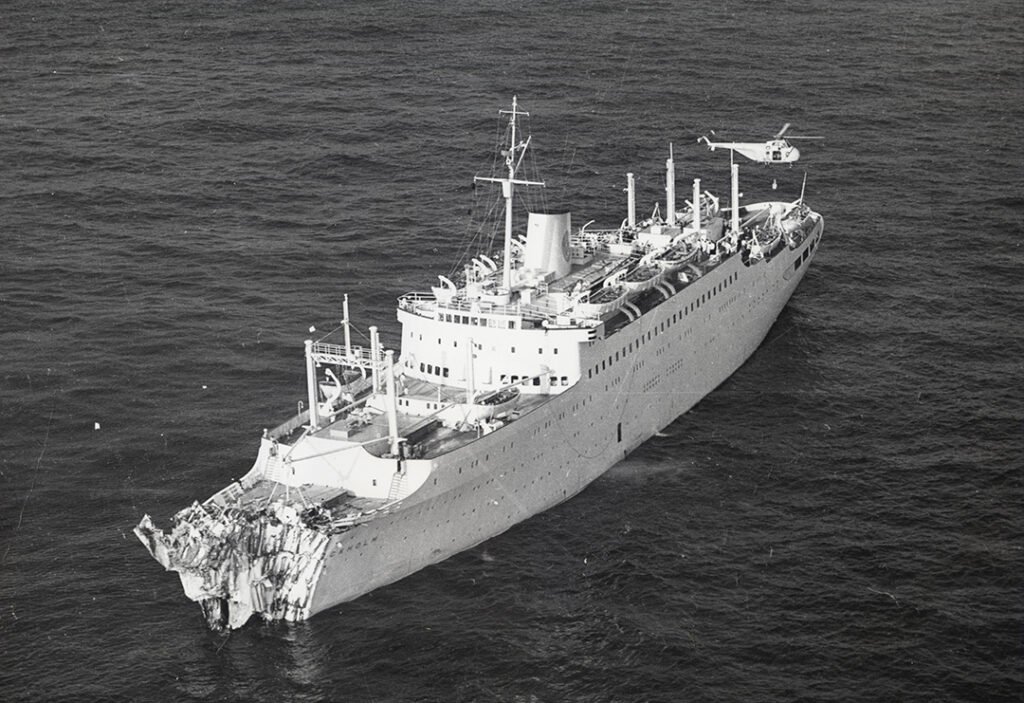
Although Stockholm was heavily damaged with what was left of her reinforced bow smashed in like an accordion, she remained seaworthy. Five of her crew were killed instantly, along with 46 of the Andrea Doria’s complement, but Stockholm stayed at the scene to rescue the Doria’s survivors, along with the legendary French liner SS Île de France. In the wreckage of the Stockholm’s bow, quite miraculously, one of the Doria’s passengers, 14-year old Linda Morgan, was discovered with slight injuries.
As the Doria rolled over and sank, Stockholm slowly limped back to New York, where she disembarked passengers and crew and was eventually dry-docked for the addition of a new bow, costing a then princely sum of a $1 million. The case was soon settled in the courts with no official blame assigned to either line, although there is much fault being attributed to both sides to this day.
Iron Curtain Cruising
Stockholm returned to service for Swedish American Line and remained with them until 1960, when she was sold to the East German government and renamed MS Volkerfreundschaft (“friendship between nations”) and operated by Deutsche Seereederei, who were the predecessors to now Carnival-owned Aida Cruises. Volkerfreundschaft was little changed from the Stockholm era, retaining the ship’s final Swedish American Line layout and specially commissioned artworks. At times, she would even be charted to Swedish-owned Stena Line for special cruises in the Swedish market.
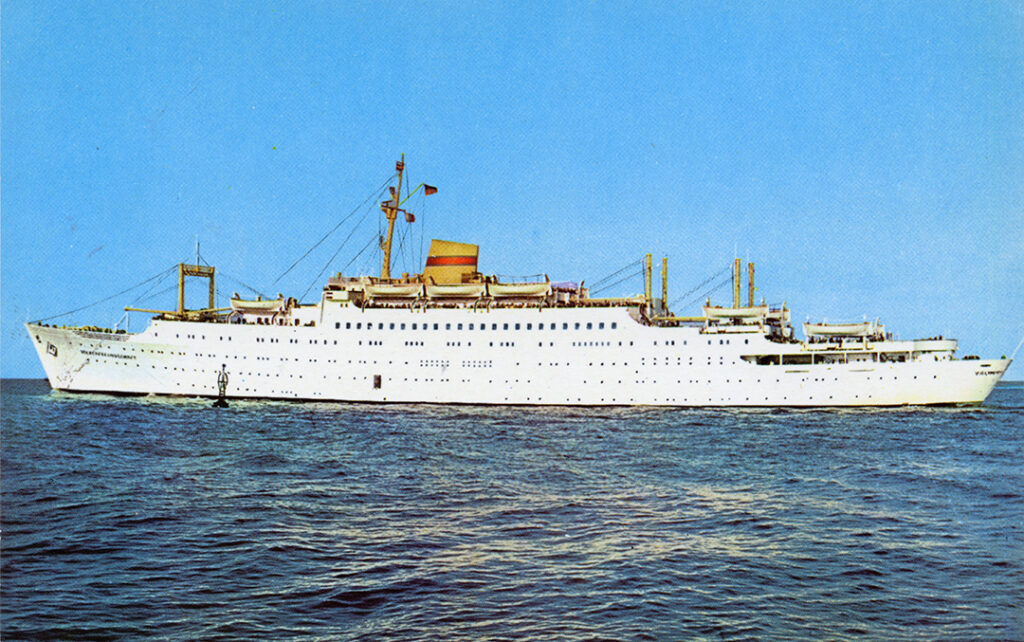
During the Cuban Missile Crisis in 1962, Volkerfreundschaft had to pass through the American blockade of Cuba with a contingent of East German and Czech passengers and in 1968, she collided with the German submarine-chaser Najade when trying to retrieve one of her East German passengers who fell into the sea while trying to defect. There was another incident off the Florida keys when four crew jumped into the sea from the Cuba-bound ship and were rescued by a relative with a boat. And, while her East German career was otherwise largely successful, there was one final incident in 1983, when she collided with the West German submarine U26 in the Bay of Kiel.
In 1985, Volkerfreundschaft was laid up and offered for sale at Southampton under the shortened name of Volker. Largely expected at her age to become scrap fodder, she was nonetheless chartered by the Norwegian government to house refugees at Oslo under the name Fridtjof Nansen.
Rebuilt From Stem To Stern
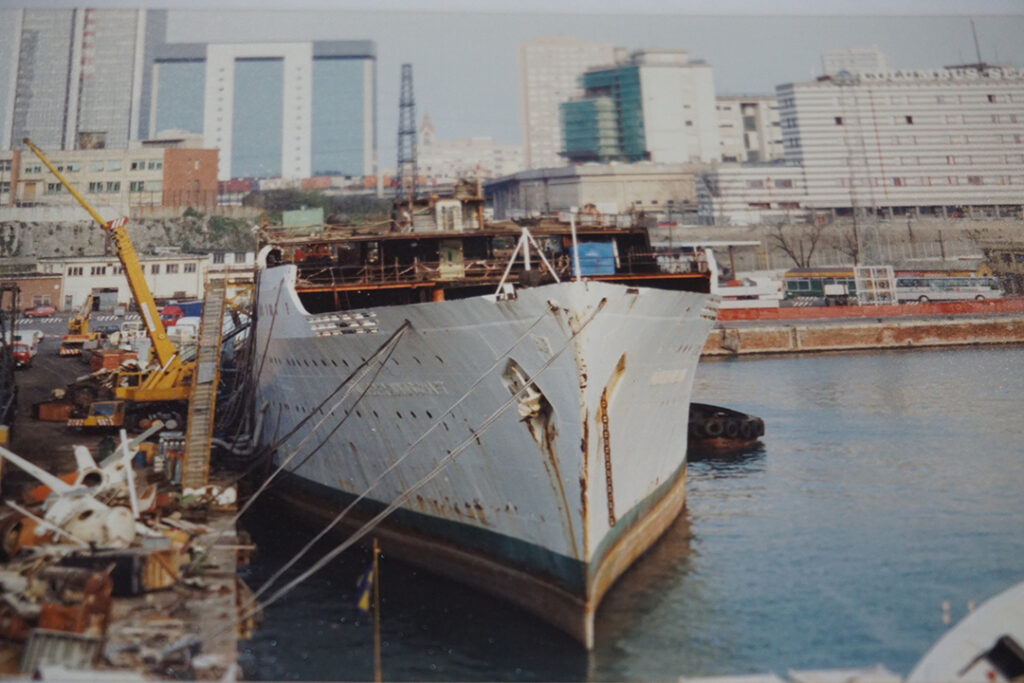
In the late 1980s, when some cruise lines were seeking out older tonnage to convert into modern cruise ships, another reprieve came the ship’s way. Lauro Lines, the operators of the MS Achille Lauro, purchased her and renamed her Surriento. The ship was towed to Genoa, where the engines and superstructure were removed. Sadly and typically, in the process, the original Swedish American Lines artworks and many beautiful vintage fittings were destroyed.
Gerardo De Rosa, the famed captain of the Achille Lauro during that ship’s notorious hijacking, supervised the former Stockholm’s complete transformation into a stylish cruise ship. New engines and a much larger superstructure were added, increasing the gross tonnage to 15,614 with a new capacity for 556 passengers in far more spacious accommodations. Aside from that sturdy hull and some portholes, basically nothing would remain of the old Stockholm.

At first renamed Italia I, then Italia Prima, the former liner was given chic new public rooms decorated by then Milan-based Studio De Jorio, fresh from their conversion of Costa Line’s SS Eugenio C and MV Enrico C, and the modernization of StarLauro’ Cruises’ (now MSC Cruises’) Achille Lauro and Monterey.
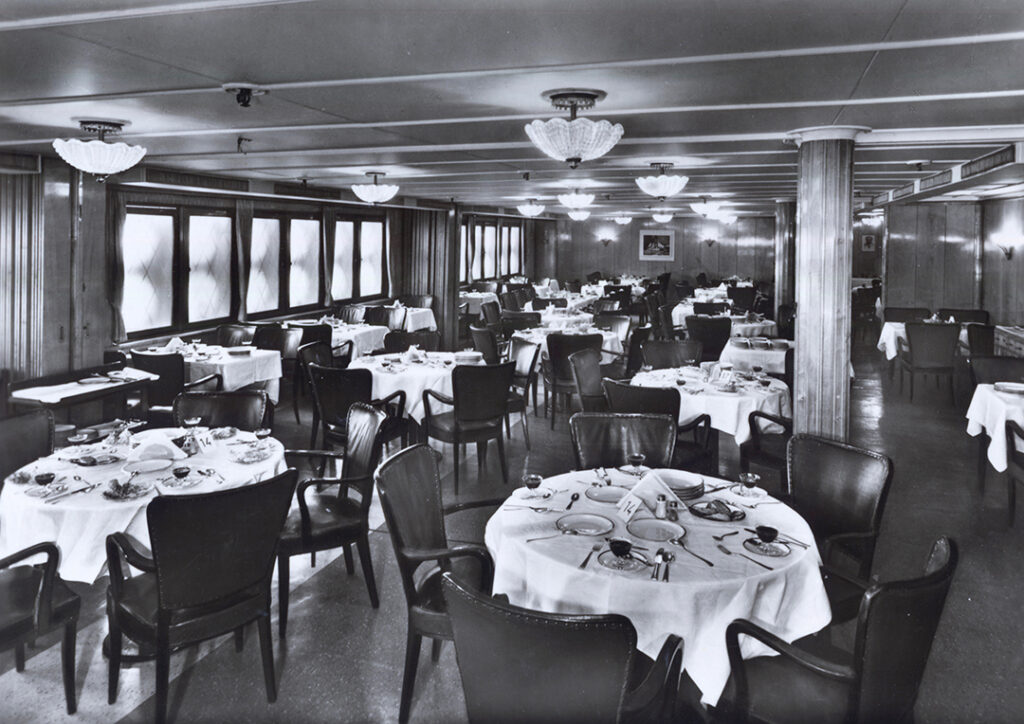
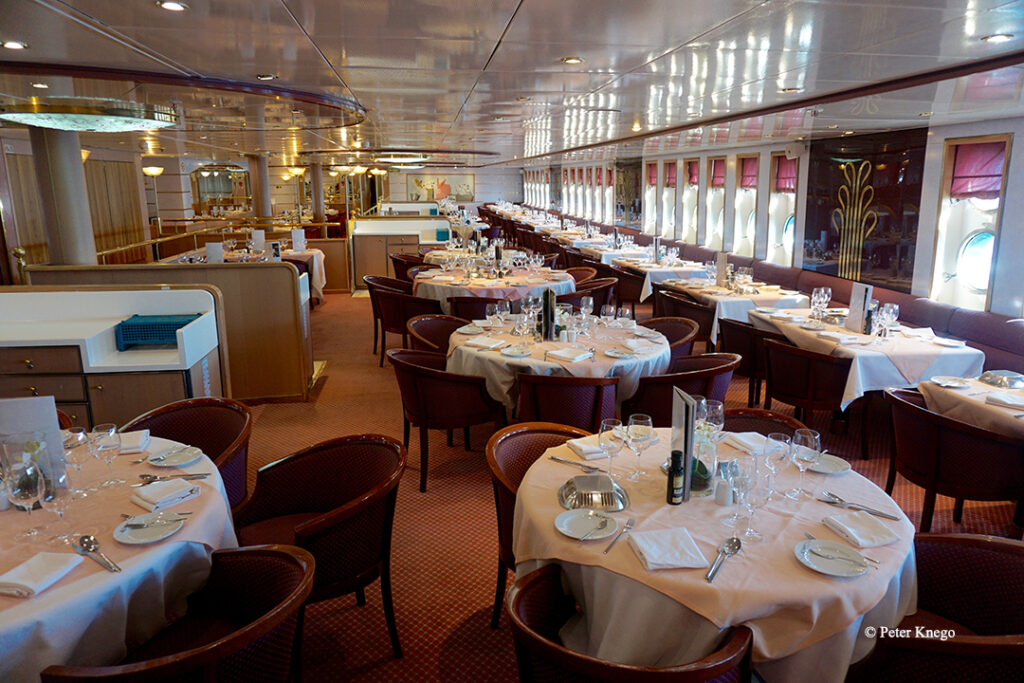
De Jorio used a great deal of polished brass, marble and rich color schemes in the public areas, which included a small atrium, a large showroom, a theater, a casual dining buffet, a disco, a library, a chapel, a card room, a casino, a gym, a small spa, and a restyled and enlarged dining room that utilized the original double portholes — which were among the only features left from Stockholm. Every cabin, including nine suites with sitting rooms and balconies, featured a bathtub.

Italia Prima‘s deck areas included a teak-lined, full wrap-around promenade, a beautiful stern lido with a marble-enshrouded pool that was framed by a semi-circular walkway on the deck above and large banks of outdoor sunning space on the top deck. Hers was a comprehensive and remarkable conversion to modern cruising and among the best ever, in retrospect.
Encounters With Prima

I first saw the Italia Prima in late 1994 from the decks of the outbound Achille Lauro at Genoa, while she was being fitted out at the San Giorgio del Porto shipyard. Only the trained eye could detect any traces of the Stockholm in the rivets and curves of her hull. Even the curvaceous stern was largely obscured by giant sponsons that provided much needed stability to compensate for the enlarged superstructure.
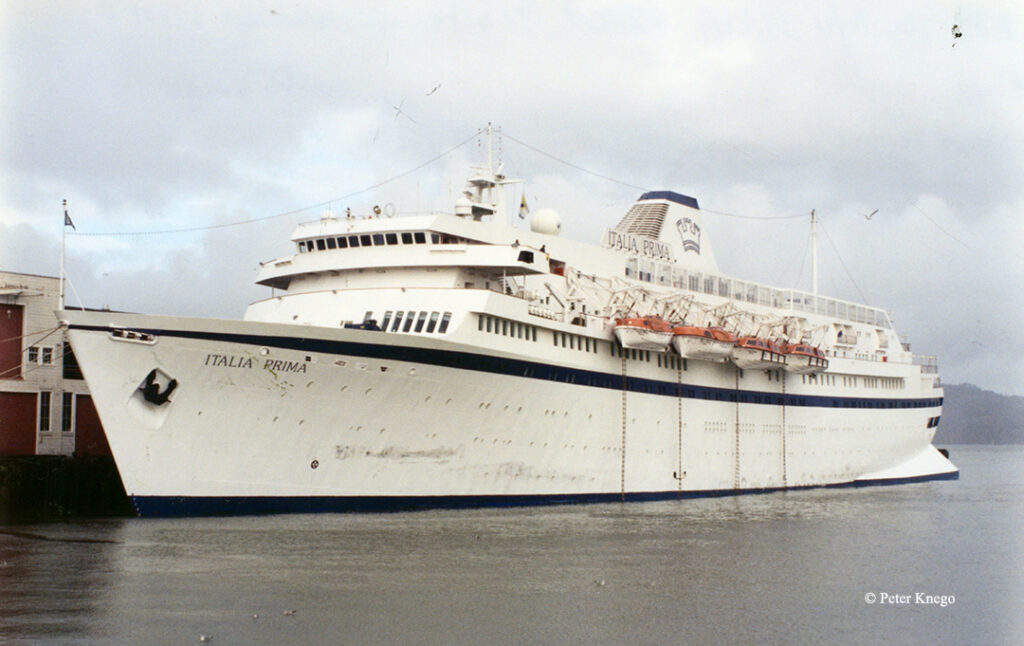
Much to my delight, Italia Prima did a world cruise in 1996, calling at San Francisco. Of course, I went up to spend a day on board and was so thrilled to encounter Captain DeRosa.
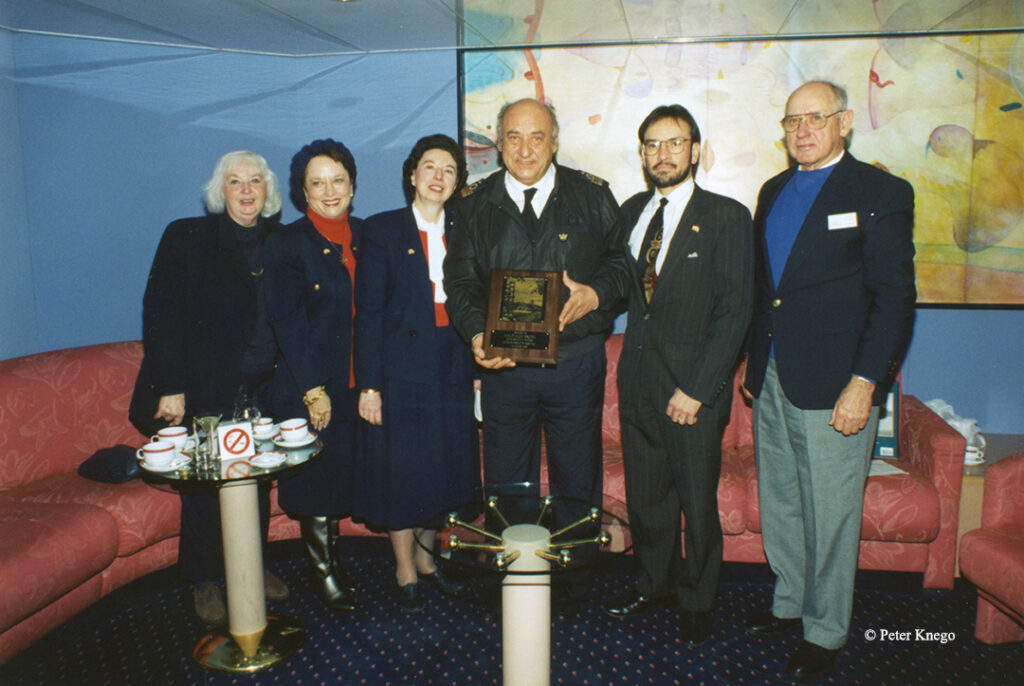
The legendary comandante (made famous by the opera written about the hijacking and also portrayed in various movies ) was a genial, warm man who cried tears of joy when I presented him with photos I had taken of Achille Lauro, which had tragically burned and sank in late 1994. He told me that since Achille Lauro was his home, it never occurred to him to take photos. In return, he gave my friend and I complete access to Italia Prima that day, one I will always remember fondly with the gorgeous San Francisco Bay as our backdrop.
I would see her again in Los Angeles the following year, when I rented a small boat that I was able to take right up to her bow in those pre-911 security days.
Italia Prima, while an excellent and well appointed ship, was soon outclassed by a new generation of ever larger, purpose-built cruise ships. She made a profit but not enough apparently, for a slew of operators who came and went. In 2002, she was chartered to Festival Cruises and renamed Caribe for an intended Cuban cruise service that never took off. In 2004, she was sold to Arcalia Shipping, a Portuguese company with a fleet of ships that included Funchal, the other ship that her last owners also purchased and left to rot.
New Names and Owners
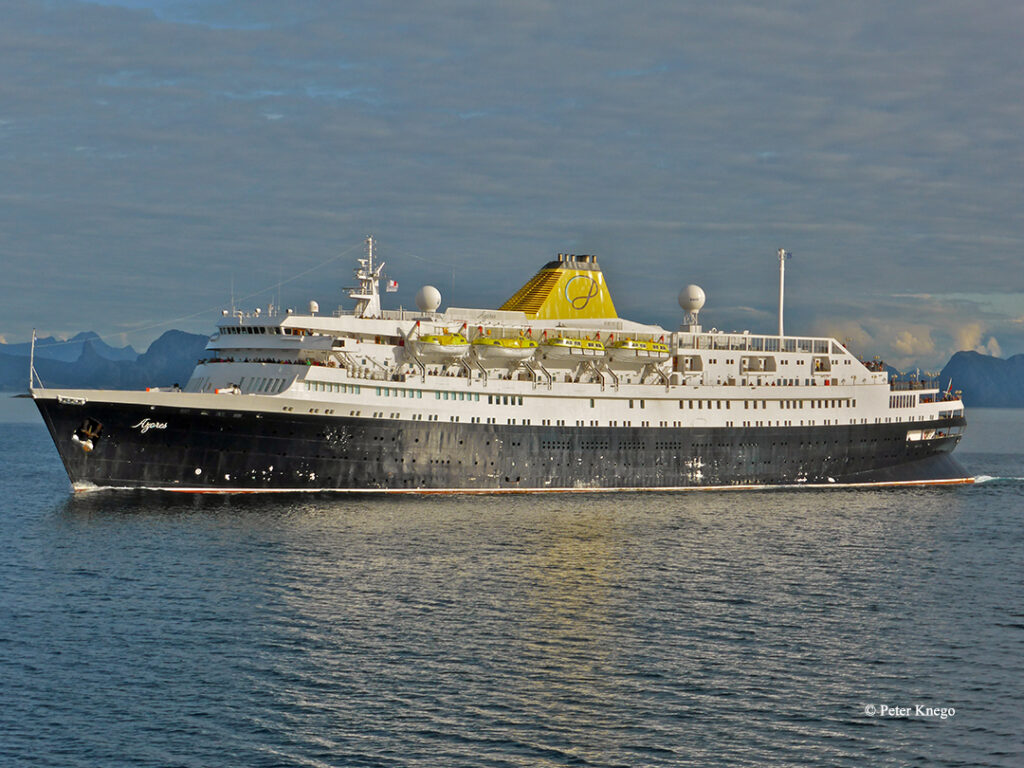
In 2005, she became Athena for Classic International Cruises. Then in 2008, pirates attacked her in the Gulf of Aden and ultimately were thwarted via a U.S. Navy patrol and the crew’s use of high powered water cannons. By 2012, Classic International went bankrupt and the ship was laid up at Marseilles. She re-emerged in 2014 as the Portuguese-cruise ship Azores, with a dark hull and handsome yellow and black funnel markings.
In 2014, while having dinner on board the old Hurtigruten ship Lofoten on a sunny evening working our way south through the Loften Islands, an announcement was made that we were about to encounter the upbound, former 1948-built Stockholm. Of course, I ran up to deck and watched in amazement as the dramatically lit Azores sailed past us, looking utterly magnificent.
At that point, I had promised myself I would sail in her. Shortly afterwards, her then owners declared bankruptcy but thankfully, she had one more life ahead of her.
In 2015, Cruise and Maritime Voyages (CMV) chartered her in tandem with French-based Rivages du Monde. Renamed Astoria, she became an instant favorite with her Brit guests for her intimate size, but CMV soon realized what all the other recent operators had experienced. She was an expensive ship to run and barely turned a profit, even when full. They soon announced her retirement in 2017 but after much protest from loyal guests, decided to extend the charter into 2018.
Fond Cruising Memories
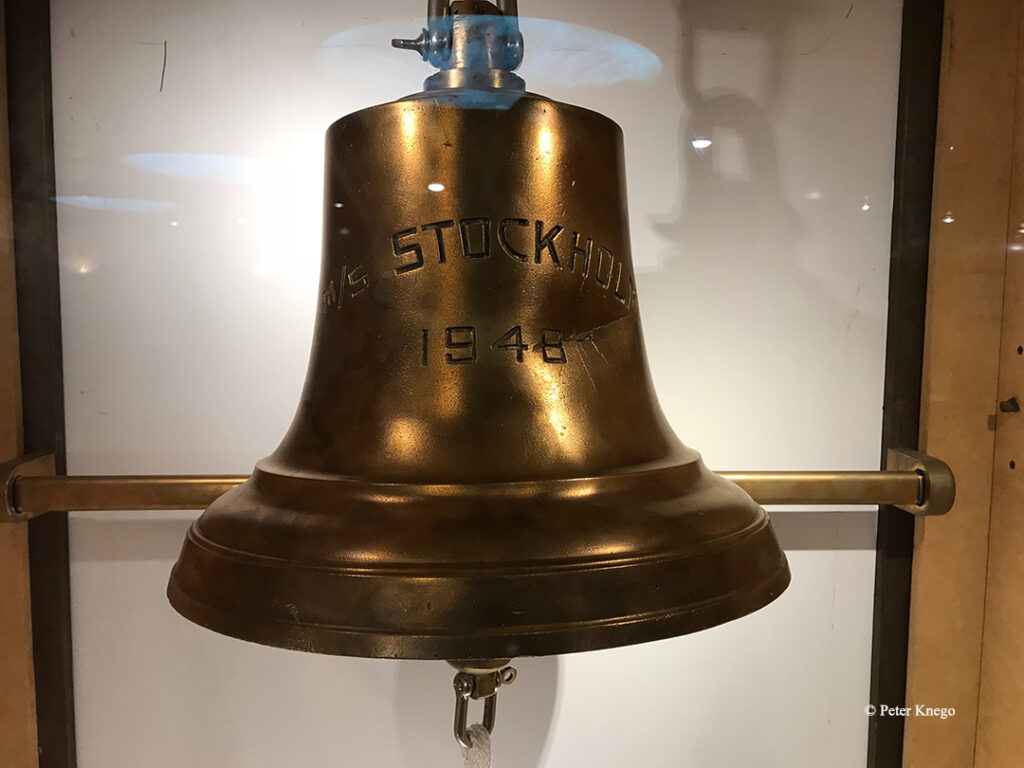
I sailed Astoria on a wonderful six-night cruise from Tilbury to Belgium and France in March of 2018, where I had the privilege of lecturing about her history and, yes, the Andrea Doria collision. It was a unique experience, all the more poignant with the dented bell from Stockholm’s bow having been recovered and displayed on board in one of the ship’s vestibules.
I thoroughly enjoyed our short time on Astoria: the ship had a wonderful, hard working crew, decent food, lovely public rooms and deck areas and was such a nice, intimate size. Today’s cruise fleet only has top luxury ships in Astoria’s size range, which is sad for those of us who prefer smaller ships and cannot afford the premium prices of the luxe lines.

CMV further extended Astoria’s charter with a season of cruises in early 2020 from Puerto Penasco, which is at the top of the Sea Of Cortez and a short drive from the Arizona border. After sending the ship across the Atlantic to begin the cruise season, the first cruise had to be cancelled due to delays caused by a storm. Thankfully, the cruise I had booked was not cancelled and for 10 nights, it was a joy to cruise through the Sea of Cortez on such a unique ship. On that trip, I also had the privilege of providing lectures about Astoria’s incredible history.
Survivor to Sunset
Alas, the Covid pandemic was upon us and Astoria only operated one more cruise before being sent back to Europe, where she was laid up. Even if Brock Pierce had not bought the ship, I doubt she would still be with us, when so many larger, newer ships were sent off to the scrap yards during Covid and its devastating aftermath.
Astoria is a ship that certainly made her mark in maritime history. Some will never forgive the unfortunate accident she endured, but there are many others who cherish her “survivor” legacy and those happy times on board during her latter cruising years. With her goes one of the few remaining small, affordable cruise ships, the survivor of one of the most notorious seafaring disasters, and the last Swedish American liner.
RIP to Astoria and ‘tack’ (“thanks” in Swedish) Stockholm for a fascinating 77 years.
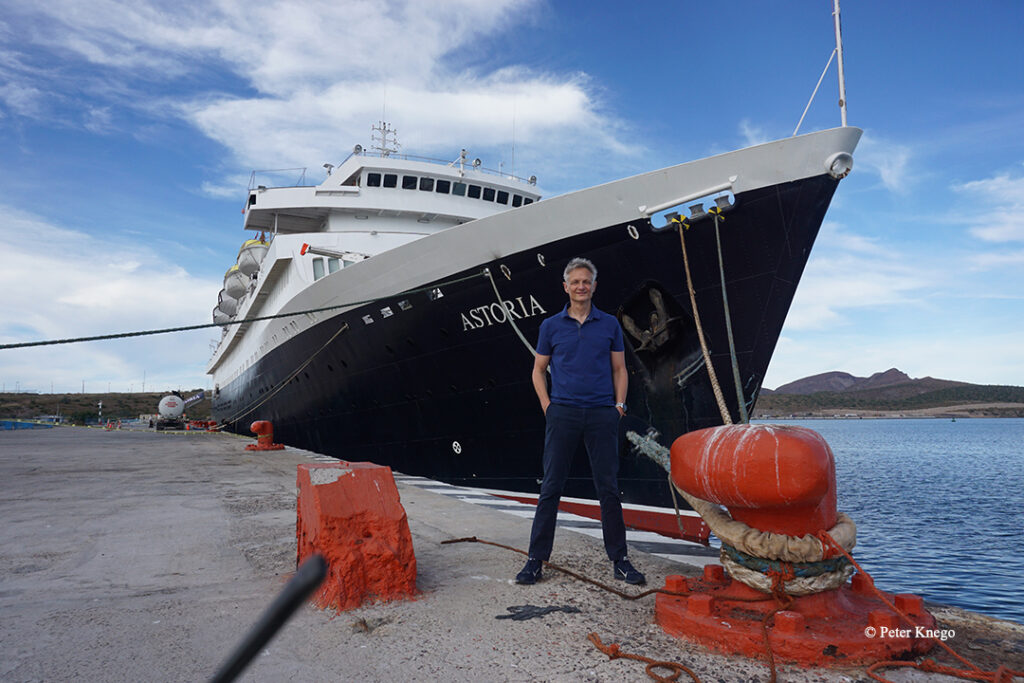
Peter recently launched a new podcast called “A Little Bit of Ship Banter: A MidShip Cinema Podcast.” Search for it on your favorite podcast platform.
He also regularly uploads to his YouTube channel MidShipCinema.


